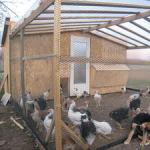| Mountain ash | |
| |
|
| scientific classification | |
|---|---|
| Kingdom: |
Plants |
| Department: |
flowering plants |
| Class: |
Dicotyledonous |
| Order: |
Rosaceae |
| Family: | |
| Subfamily: |
Plum |
| Tribe: |
apple trees |
| Genus: | |
| View: |
Mountain ash |
| International scientific name | |
|
Sorbus aucuparia L., 1753 |
|
| View in taxonomic databases | |
| CoL | |
Mountain ash(lat. Sorbus aucuparia) is a deciduous tree of the rose family ( Rosaceae).
Description

Botanical illustration from the book by O. V. Tome Flora von Deutschland, Osterreich und der Schweiz, 1885

Inflorescence

infructescence

fruit trees
A tree 4-15 (sometimes up to 20) m high with an ovoid crown and a shallow root system. Young branches are downy, with a gray smooth bark, later grayish-white. Leaves alternate, 10-20 cm long, lanceolate in outline, with 10-15 leaflets; leaflets 3-5 cm long, 1-15 cm wide, from oblong to oblong-lanceolate, usually entire in the lower part, serrated in the upper part, dull green above, glaucous or grayish below. Young leaves are pubescent below at the base, later ones are glabrous.
Dense corymbose inflorescences are located at the ends of shortened shoots, 5-10 cm in diameter, pubescent, rarely glabrous. The flowers are white or pinkish, 8-15 mm in diameter, with an unpleasant smell of trimethylamine, reminiscent of the smell of horse manure. Calyx first pubescent, then glabrous, sepals ciliated; petals 4-5 mm long, rounded, pubescent above. The fruits are almost spherical, about 1 cm (usually not more than 1.5 cm) in diameter, orange-red or bright red, juicy. Seeds are usually 3 in number, narrowly oblong, sharp at the ends, reddish.
Chemical composition
The bitterness of the fruits is given by sorbic acid glycoside (up to 0.8%). At the first frost, the glycoside is destroyed, and the mountain ash becomes sweeter. With the breakdown of the glycoside in the fruits, the level of sorbic acid increases, such fruits can be stored without any processing. Amygdalin and fatty oil were found in the seeds (up to 22%); in leaves - about 200 mg% of ascorbic acid, flavonoids; in flowers - quercitrin and spireoside; in the bark - tannins.
Spreading
The range covers Western Europe, Asia Minor, the mountains of Kazakhstan and Kyrgyzstan, North Africa. In Russia, it is distributed in the European part, Crimea, the Caucasus, the Far East, Kamchatka, Siberia, and the Amur region.
Often found in all natural and administrative regions of the Saratov Right Bank. In the Rtishchevo district, it was noted in the green spaces of the city of Rtishchevo, as well as in the plantations of the former nursery of the South-Eastern Railway.
Features of biology and ecology
It grows in the undergrowth of forests of various composition, often spruce, growing on the edges, clearings and cutting areas, less often among meadows, also on rocky or stony places, along the cliffs of river banks.
It grows quickly, in one year it grows by 0.5 m.
Blossoms in May - June, fruits ripen in September - October; berries, if they are not eaten by birds, usually remain on trees until deep winter. Fruits from 5-7 years of age annually. A good rowan harvest is usually observed once every 1-3 years, the largest yield is from 35-40 years. One tree can produce up to 80-100 kg of fruit. With a lack of light, it develops poorly and almost does not bear fruit. Propagated by seeds and root suckers. Lives up to 200 years.
Economic importance and application
It has long been used as a fruit and medicinal plant, as well as an ornamental plant with pyramidal and weeping forms.
In medicine
The bark exhibits antibacterial activity. A decoction of it is used for hypertension. Branches in folk medicine - for rheumatism.
Infusion and decoction of flowers are used for diseases of the liver, kidneys and urinary tract, organs of the gastrointestinal tract, metabolic disorders, hemorrhoids, colds, coughs. Used in gynecology. In addition, the decoction is used for goiter. Infusion of flowers and fruits - as a diaphoretic for colds.
A decoction of leaves and fruits in folk medicine is used for scurvy, general weakness (after serious illnesses, operations), beriberi.
Fruits are allowed in medical practice for hypovitaminosis. In India, they are used - for scurvy, hemorrhoids, liver diseases. In folk medicine as a diuretic, laxative, hemostatic, vitamin, contraceptive, antidysenteric; with dysmenorrhea, malignant tumors. Infusion (inside) - for gastritis with low acidity of gastric juice, hemorrhoids, diseases of the kidneys, liver, atherosclerosis, bleeding; decoction (inside) - with hypovitaminosis, general weakness. In Western European countries - with diseases of the liver, kidneys, ascites, diarrhea, rheumatism, metabolic disorders, hypovitaminosis, whooping cough, throat diseases, glaucoma; externally - as a wound healing. Juice - for anemia, asthenia, gout, hemorrhoids, malignant tumors, low acidity of gastric juice, gastritis, hypertension, vitamin deficiency, glaucoma, whooping cough, dysmenorrhea, diseases of the liver, kidneys, ascites, atherosclerosis. Syrup - for rheumatism, kidney stones, bladder, violation of salt metabolism.
Rowan fruits are part of vitamin and multivitamin preparations.
In other areas

rowan honey
Rowan is highly valued as an ornamental plant, and therefore it is often used in landscape gardening. It is also used in forest reclamation, snow protection and wind-resistant plantations.
The wood is suitable for carpentry, turning, furniture making, and for making musical instruments.
The bark stains the tissues in red-brown tones, and the branches in black. Leaves turn brown.
The kidneys have an insecticidal and raticidal effect. The fruits are used in veterinary medicine - for diarrhea in calves.
It is a good honey plant. It gives the bees a significant amount of nectar and pollen in the spring, during the period of a small flow. Sometimes the flowering of mountain ash coincides with the onset of temporary cold weather, and then its flowers are not visited by bees. Honey is coarse-grained, has a reddish tint and a strong peculiar aroma. The total honey productivity under favorable conditions is about 30-40 kg per 1 ha of plantation.
Forage plant. Fruit yield - up to 2.5 t/ha. Edible fresh and processed, used in the confectionery industry. They are used fresh and for the manufacture of juices, jams, jams, candied fruits, mashed together with sea buckthorn and apples. They make stuffing for sweets, and also make kvass, tincture, rowan vodka and cognac. Dried - a substitute for tea. They can serve as raw materials for the preparation of vitamin preparations. Sorbitol can be prepared from fruits, replacing sugar. The fatty oil contained in the seeds is suitable for food, pleasant to the taste.
Cultivated. Differs in high cold and drought resistance. In this regard, it is used in breeding work when breeding cold-resistant and drought-resistant varieties of pome fruit plants. There are large-fruited, dessert varieties bred by I. V. Michurin and other breeders.
In the folk calendar there is a day of Peter-Paul fieldfare, which falls at the end of September - the time of ripening rowan berries. On this day, branches with fruits were tied into bundles and hung under the roofs of houses. This custom is associated with the notion of mountain ash as a tree that can protect a person from all sorts of troubles. It was distributed not only in Russia, but also in Western Europe, the Baltic States. Rowan branches decorated not only living quarters, but also sheds, gates, even rowan branches were stuck at the edge of each field.
In central Russia, mountain ash was used in wedding ceremonies. Its leaves were spread in the shoes of the newlyweds, the fruits were hidden in the pockets of their clothes - all this was to protect against sorcerers and witches. In addition, rowan is a symbol and guarantee of happiness and peace in the family, so they tried to plant rowan near the house.
Literature
- Glukhov M. M. Honey plants. Ed. 7th, revised. and additional - M.: Kolos, 1974. - S. 203-204
- Trees and shrubs of the USSR. Wild, cultivated and prospects for introduction / Ed. in 6 volumes. T. III. Angiosperms: families trochodendrovye - rosaceae. - M., L.: Publishing House of the Academy of Sciences of the USSR, 1954. - S. 465-466
- Elenevsky A. G., Radygina V. I., Bulany Yu. I. Plants of the Saratov Right Bank (compendium of flora). - Saratov: Sarat Publishing House. pedin-ta, 2000. - ISBN 5-87077-047-5. - p. 38
- Universal encyclopedia of medicinal plants / Comp. I. Putyrsky, V. Prokhorov. - Minsk: Book House; M.: Makhaon, 2000. - S. 250-252
- Flora of Central Russia: Identifier Atlas / Kiseleva K. V., Maiorov S. R., Novikov V. S. Ed. prof. V. S. Novikov. - M.: CJSC "Fiton +", 2010. - S. 302
| Flora and fauna of the Rtishchevsky region | |||||||
|---|---|---|---|---|---|---|---|
| Flora of Rtishchevskiy district |
|
||||||
| Mushrooms of the Rtishchevsky district |
|
||||||
| Fauna of the Rtishchevskiy district |
|
||||||
| Red Book of the Saratov Region | |||||||
| Rtishchevo and Rtishchevo district in topics | ||||
|---|---|---|---|---|
| Symbols and awards |
|  |
||
| People of the city and region | ||||
| Administrative- territorial division |
|
|||
Rowan - perhaps one of the most common trees in Russia. With confidence, you can find out that every inhabitant of our country knows exactly what a mountain ash looks like. Older generations remember with pleasure the taste of sour berries, which become sweeter in the cold - a small part of childhood that remains with a person for life.
This plant can grow almost anywhere. This is explained by her unpretentiousness and endurance. That is why it is most often chosen for decorating a personal plot. Rowan can become really important landscape design element country house. Its advantages lie not only in its endurance, as mentioned above. The appearance of the rowan tree is pleasing to the eye and attracts attention, which can look advantageous against the background of monotonous decorative and complex decorations.
This short article, as you could already understand from the previous paragraphs, will be entirely devoted to mountain ash. This well-known plant is of particular interest not only to botanists, but also to the general reader, who is drawn to interesting information about everything at once.
Rowan - description. Rowan characteristic
To get started, you just need to describe the mountain ash, as well as answer a very common question that applies to this plant. Many users on the network ask the question "Is the mountain ash a shrub or a tree?". If you think about it, then this question is very logical, if you look closely at the mountain ash, you really won’t understand right away whether it’s a bush or still a tree, its structure fits both signs, so it can be both bush and in the form of a tree.
 Finding the answer to this question is very easy. It is enough just to enter “Wikipedia mountain ash” into the search engine line, and all the information about it will be posted in the very first paragraph of the article on this comprehensive resource. The fact is that this plant itself is a tree, but at the same time there are also shrub varieties. The family of the tree is Pink, the root system is well developed, reaches 2 meters in depth and extends to 5 meters in diameter, the type of fruit is spherical, the height of the tree usually reaches 6-15 meters. Rowan looks like a not very tall tree with a straight trunk, as well as a crown, the shape of which can be described as ovoid.
Finding the answer to this question is very easy. It is enough just to enter “Wikipedia mountain ash” into the search engine line, and all the information about it will be posted in the very first paragraph of the article on this comprehensive resource. The fact is that this plant itself is a tree, but at the same time there are also shrub varieties. The family of the tree is Pink, the root system is well developed, reaches 2 meters in depth and extends to 5 meters in diameter, the type of fruit is spherical, the height of the tree usually reaches 6-15 meters. Rowan looks like a not very tall tree with a straight trunk, as well as a crown, the shape of which can be described as ovoid.
Rowan trees are distinguished by the smoothness of the bark, as well as a grayish color. . Leaves can be of different shapes: oblong-lacent or simply oblong, alternate, also called imparipinnate. This plant is indeed a very beautiful tree, which determines its popularity as an ornamental plant. The old leaves of this shrub are not pubescent, unlike the young ones.
Rowan is especially beautiful during its flowering, when it begins to bloom, and also looks very pretty in autumn. The flowers are collected in a kind of panicle, they can be white or have a pinkish tint. The smell, however, of rowan flowers is not very pleasant. This plant bears fruit annually, but do not be naive to believe that it is possible to harvest the “harvest” within the specified time frame. About once every three years, the plant gives a full "harvest".
Rowan tree usually blooms in late spring or early summer. Wherein fruit development begins in autumn in September. Gradually, from white berries, they turn into red or black fruits. Of course, maybe the berries of a mountain ash tree cannot stand on a par with berries of cherries or grapes, if we compare their taste, but in terms of usefulness they may well argue with them.

Some features of growing
When planting any plant, be sure to first learn about the features of its cultivation. This will avoid possible subsequent death of the plant as a result of improper care.
- In the case of mountain ash, you can not worry when planting it. As already mentioned above in this article, this plant is very, very hardy and unpretentious, and feels quite comfortable on almost any soil. Also, do not forget about another important quality of this plant - frost resistance. This ability allows the mountain ash to endure even the most severe winters quite calmly. In addition, the plant boasts resistance even to high temperatures.
- This plant is ideal for lovers of beautiful landscapes who prefer to put a lot of effort into caring for plants, as it requires little to no constant, regular watering. True, in the summer it is recommended to periodically moisten the soil under the rowan tree. Also, thanks to its strong and developed root system, the plant will not fall in front of strong gusts of wind. It should also be noted that the plant is resistant to highly polluted city air.
The value of mountain ash as an ornamental plant
It has already been said above that mountain ash is often used by landscape designers as an ornamental plant. Moreover, both rowan trees and shrubs are used. Rowan popularity used for decoration, due to a number of reasons. First of all, be sure to indicate the beauty of the crown of a mountain ash tree or shrub, which distinguishes with density and compactness. Of course, plants with a “weeping” crown shape are most often used.
It is also worth noting the beauty of rowan leaves, which are distinguished by their unusual shape. In addition, in autumn the leaves become orange-reddish tint. In addition, bright rowan berries, which are able to retain their beautiful color even until late winter., rowan leaves are also very good for autumn herbarium.
Types of mountain ash
 Many people do not even know that there are different types of mountain ash. Most often you can stumble upon rowan species with red berries, but there are also chokeberry varieties mountain ash (photo), which are highlighted as a separate species. It is worth noting that the fruits of both types, both red and black, have medicinal properties. The most common type of this plant is the mountain ash. In total there are more than forty varieties.
Many people do not even know that there are different types of mountain ash. Most often you can stumble upon rowan species with red berries, but there are also chokeberry varieties mountain ash (photo), which are highlighted as a separate species. It is worth noting that the fruits of both types, both red and black, have medicinal properties. The most common type of this plant is the mountain ash. In total there are more than forty varieties.
Serious work on the selection of rowan species was carried out at one time by the famous Russian scientist Michurin. The scientist brought out several new hybrids of this plant. It was thanks to his research that chokeberry which has already been mentioned in this article. It, in principle, is very similar to the common rowan species, but does not belong to this species. In fact, this is a separate hybrid plant, which has its own name - chokeberry.
medicinal properties
The fruits of mountain ash have long been used by people as a folk remedy. Rowan berries contain various vitamins, as well as glucose, fructose and sorbic acid. All these components very beneficial to the body especially weakened by disease.
- Some ailments should be identified, in which decoctions from useful rowan berries are sometimes used. It is recommended to drink such decoctions for hypertensive patients and people suffering from atherosclerosis. Also, this folk remedy can help with disorders of the heart, kidneys and liver. Rowan juice can be used in cases where a person has gastritis, hemorrhoids or low acidity. One of the useful components of the fruits of this plant - sorbic acid - can become a serious assistant in the fight against dysentery bacillus and staphylococcus aureus.
- The berries of the plant are sometimes used as a food preservative and also for water purification. Our ancestors even had a certain way of purifying water - at night, a branch of this plant was simply thrown into a bucket of water. This method not only allowed the water to remain fresh for a long time, but also gave a pleasant aftertaste.
The meaning of rowan in ancient rites
 The importance of mountain ash was noted in antiquity. Above, cases of using the plant as a decorative ornament and medicine have already been indicated, but even in pre-Christian Rus', in some regions, people used mountain ash for certain rituals. For example, there were wedding ceremonies, which involved lining shoes with rowan leaves for the newlyweds, as well as rowan berries were put in their pockets.
The importance of mountain ash was noted in antiquity. Above, cases of using the plant as a decorative ornament and medicine have already been indicated, but even in pre-Christian Rus', in some regions, people used mountain ash for certain rituals. For example, there were wedding ceremonies, which involved lining shoes with rowan leaves for the newlyweds, as well as rowan berries were put in their pockets.
The specified plant in this case used as a symbol of protection against the possible intrigues of witches and sorcerers. Also rowan trees for the same purpose were planted next to the house. Rowan was also used to expel spirits that brought various diseases and ailments to people.
In addition, the value and significance of mountain ash among the people emphasizes the existence various legends that have been passed down through generations by word of mouth. For example, you can point out an interesting and original legend that tries to explain the presence of bitterness in the taste of rowan fruits. According to this legend, the mountain ash was created by the devil himself from Eve's tears when she was expelled from paradise.
It was believed that this served as a kind of symbol of Satan's victory over mankind. But after the Creator discovered the similarity of the rowan tree leaves with the cross, he took it from the devil's garden. This could not please the devil, who later set out to destroy his own creation so that it would not go to the Creator and people. But he did not succeed in doing this, only as a result of an attempt rowan berries have become bitter.
The decorative and medicinal properties of mountain ash, which have already been mentioned in this article, are not the only advantages of this beautiful plant. The qualities and properties of the wood of this tree make it possible to make various joinery products from it. Here it is necessary to mention the main advantages of rowan wood- strength and elasticity.
 As already mentioned, there are quite a few different varieties of this plant, but one of them boasts rather large fruits. Berries of large-fruited mountain ash really large compared to the fruits of other varieties of this plant. One berry can weigh twenty grams, and have a diameter of three and a half centimeters. The fruits of large-fruited mountain ash are very tasty. At the same time, this variety is not as unpretentious as other types of mountain ash. She does not really like winter, so she needs special care. An interesting fact about the large-fruited mountain ash is that it was bred in the Crimea by the Crimean Tatars.
As already mentioned, there are quite a few different varieties of this plant, but one of them boasts rather large fruits. Berries of large-fruited mountain ash really large compared to the fruits of other varieties of this plant. One berry can weigh twenty grams, and have a diameter of three and a half centimeters. The fruits of large-fruited mountain ash are very tasty. At the same time, this variety is not as unpretentious as other types of mountain ash. She does not really like winter, so she needs special care. An interesting fact about the large-fruited mountain ash is that it was bred in the Crimea by the Crimean Tatars.
Rowan with sweet fruits instead of bitter, it was first found in the village of Nevezhino, Vladimir Region. From there it spread throughout Russia. It was this variety with sweet fruits, called Nevezhensky, that was used at the beginning of the twentieth century for the mass production of tincture, which was called Nezhinskaya.
rowan picture








Rowan is a tree of the genus Sorbus of the Rosaceae family.
Characteristics of culture
Rowan is a slender tree up to 10 meters high with light greenish-gray bark. Rowan has a spreading openwork crown and large unpaired petiolate leaves with a serrated edge. The leaves are arranged alternately, consist of 9-17 oblong leaflets.
The flowers are collected in dense multi-flowered inflorescences-shields up to 10 cm in diameter, located on shortened shoots. The calyx consists of five green sepals, the corolla is white with a diameter of 1.5 cm. Flowering begins in May-June.
The fruits of mountain ash are bright red and red-orange in color, have a spherical shape, reach 1-1.5 cm in diameter. The fruits are very juicy, have a bitter taste, ripen in August or September, depending on the variety. In addition, the berries do not fall and can hang on the branches all winter until they are pecked by birds.
Spreading
Mountain ash grows in almost all regions of the European part of Russia. The culture is bred as an ornamental plant in gardens, parks, squares and roadside plantings, in nature there are wild varieties that grow on the edges, glades, in forest ravines of mixed forests, as well as along the banks of rivers and reservoirs. Since the 20th century, the culture has been grown as a food plant.
Culture varieties
The most popular rowan varieties:
- Scarlet large is a rather valuable variety of this crop. It has large fruits of red-scarlet color, visually resembles a cherry. It has a tart taste without bitterness.
- Bead - the variety is represented by a low tree with ruby-red fruits that taste like cranberries. Winter-hardy, disease-resistant variety.
- Vefed - the variety is represented by a low tree with orange-pink fruits, characterized by high winter hardiness.
- Pomegranate - the variety is represented by a hybrid of mountain ash with hawthorn. The tree reaches 3-4 meters, the fruits are large with a sweet and sour taste without bitterness. It has high winter hardiness and good yield.
- Beauty - the variety is represented by hybrids of mountain ash and pear. The tree has a pyramidal shape, the height of which reaches 6 meters. The fruits of this variety are large, oblong, bright orange-red in color with a tart taste.
- Hope - the variety is represented by a short tree, with medium fruits. The variety is fast-growing and high-yielding.
- Ruby - the variety is characterized by a dwarf plant, whose height is 2-2.3 m, has a spreading crown. The fruits have a dark ruby color and a pleasant sweet and sour taste.
- Titan - the variety is represented by a hybrid of mountain ash, pear and red-leaved apple. A tree of medium height with a wide rounded crown, has fruits of dark red color with a bluish bloom. The variety is winter-hardy.
- Sorbinka - the variety is characterized by a medium-sized tree with large yellow-red fruits with a pleasant refreshing taste. The variety is high yielding.
Growing conditions

rowan blossom
Almost all varieties of mountain ash prefer sunny places, but they can easily tolerate partial shade. The culture grows well on loamy soils, does not tolerate smoke and gas pollution, and is undemanding to other conditions. Rowan prefers high humidity, but does not tolerate waterlogging and high groundwater. There are varieties that are tolerant of dry soil, such as Finnish mountain ash.
Soil preparation and planting
Rowan can be planted both in spring and autumn. Landing pits are prepared in advance, usually 2-3 weeks before planting. They dig holes with a diameter of 80-100 cm, a depth of 50-60 cm, 1-2 buckets of humus or compost, 150-200 g of superphosphate, 60-80 g of potassium chloride or 500 g of wood ash are added to the bottom of the pit, thoroughly mixed with the topsoil .
Low-growing varieties of mountain ash are planted according to the scheme 4 × 3 m, tall ones - 6 × 5 m. Under the roots, when planting, the soil of the upper layer without fertilizers is poured, the seedlings are planted 4-5 cm deeper than the root neck. After planting, the plants are watered abundantly (two buckets per seedling), then mulching is carried out with peat or humus. For two-year-old seedlings, it is recommended to remove the skeletal branches by 1/3 of the length and shorten the central conductor so that it is 20 cm higher than the skeletal branches.
culture propagation
The culture can be propagated by cuttings, grafting and seeds. Most often, gardeners propagate mountain ash by cuttings, and decorative varieties by grafting.
Propagation by seeds is a fairly simple method, however, some garden types of mountain ash do not always retain varietal characteristics, which can lead to late fruiting. In order to prepare the seeds for planting, they are laid for a long stratification in the fall. In spring or autumn, the seeds are soaked for 3-4 hours, and sown in open ground. It is worth remembering that winter crops must be mulched with a layer of fallen leaves to prevent freezing.
Reproduction by grafting is a rather complicated process, as a rule, mountain ash is grafted onto Finnish and common mountain ash to increase resistance to adverse conditions. Also, the culture is grafted onto hawthorn, chokeberry, pear or apple. Vaccination is carried out in late July - early August with the help of budding with a "sleeping" eye.
Propagation by cuttings is very often used by gardeners, it is not laborious and does not take much time. In addition, the chance of rooting reaches 60%.
culture care

Mountain ash care is not difficult, it includes regular removal of weeds, loosening the soil near the trunk circle, pruning, watering in dry weather and pest control. In areas with severe frosts, mountain ash is recommended to cover.
Pruning is carried out in early spring, best at the end of March, but before the buds swell. To obtain a dense crown, it is formed in one of two ways. A frequently used method (cascade) is a pruning on the third or fourth upper bud of each shoot of all branching orders. To limit the growth of mountain ash in height, reducing pruning is carried out, cutting off the upper part of the plant above the selected side branch.
Diseases and pests
Rowan is resistant to various diseases and pests. Most often on the culture you can find pests such as sawflies, ticks, scoop caterpillars. Mountain ash moth, apple fruit sawfly and bark beetles can settle on rowan flowers. Birds are also pests.
Rowan moth is considered the most dangerous for a plant. The pest damages up to 20% of the rowan crop, pupae easily endure winters in the soil and fallen leaves, and butterflies appear at the very beginning of summer. A week later, the butterfly lays eggs on the upper part of the berry, from which caterpillars of a pale red color, less often gray, hatch. They penetrate deep into the fruit and gnaw out the seeds.
For the fight, it is necessary to carry out regular spraying of trees in the evening, when the mountain ash moth begins to flock. The solution is prepared from coniferous concentrate or infusion of decoctions of herbs - wormwood or burdock.
Links
- Red Rowan, women's magazine myJane.ru
- Rowan biocosmetics, beauty portal myCharm.ru
Rowan is good at any time of the year. It is good in the spring, when its leaves are just unfolding, and at the turn to summer, when it blooms to replace the bird cherry. It is beautiful in autumn, when its foliage lights up with purple, and in winter, when ruby clusters of its fruits hang for a long time, to the delight of birds. True, flocks of waxwings, bullfinches, thrushes quite quickly deal with this beauty. However, it is intended for them. People also love mountain ash. For vitamin fruits, for honey-bearing, for elastic, durable wood. And just like that! For beauty. And for something else, elusive and unfamiliar to us, but familiar to our ancestors. No wonder they endowed mountain ash with magical properties, considered it a talisman that protects against evil forces. And willingly planted near the house.
Mountain ash (Sorbus aucuparia) is a tree or shrub from the Rosaceae family. This family is very numerous, which means that rowan has a lot of relatives, both near and far. In relatives, mountain ash and our main fruit trees are apple trees, pears, cherries. And cherry too. The relationship of plants is determined primarily by the structure of the flower. And it is very similar in most Rosaceae: a perianth of 5 petals and 5 sepals, a large number of stamens arranged in circles, the number of carpels is from one to many. Such is he and the mountain ash. Its flowers are collected in corymbose inflorescences, so they are more noticeable to pollinating insects.
 Sometimes the question arises: is it still a mountain ash - a tree or a shrub? What will you answer here? On the one hand, having a height of five or even ten meters - a tree, of course. On the other hand, it is generally accepted that a tree has one main trunk, and a shrub has several trunks growing from a common point. In mountain ash, this happens, and so on. As, by the way, and at a bird cherry. Well, wildlife does not fit into the framework created by man, what can you do! You can even consider a low tree, even a large shrub. The trunk of the mountain ash strongly branches, often bifurcating.
Sometimes the question arises: is it still a mountain ash - a tree or a shrub? What will you answer here? On the one hand, having a height of five or even ten meters - a tree, of course. On the other hand, it is generally accepted that a tree has one main trunk, and a shrub has several trunks growing from a common point. In mountain ash, this happens, and so on. As, by the way, and at a bird cherry. Well, wildlife does not fit into the framework created by man, what can you do! You can even consider a low tree, even a large shrub. The trunk of the mountain ash strongly branches, often bifurcating.
The rounded crown is formed by beautiful complex feathery leaves. The leaf is very large and consists of several small leaves sitting on a common awn. Their number is always odd: all the leaves are paired, and one, at the top, is unpaired. And such a lace is formed by these feathery leaves - the artists will envy!
Mountain ash is not very demanding on soils, it is frost-resistant and very widespread. Its range is the whole of Europe, it is also found in the Caucasus and Asia Minor. In the north it reaches the Khibiny mountains. Behind the Urals, the ordinary mountain ash is replaced by the Siberian mountain ash, which, however, is considered by many to be only a variety of mountain ash. Rowan is a forest tree of the second tier. But it does not tolerate shading well, therefore it grows mainly on forest edges, in clearings, clearings.
In late May - early June, the mountain ash blooms. Its flowering is an important phenological trait. The mountain ash has blossomed - summer has begun. The flowers are white, rather small, but collected in inflorescences and thus more visible to insects. Bees, bumblebees willingly visit mountain ash, collecting nectar and pollen. And along the way they carry pollen from one flower to another. Rowan is an important honey plant.
The fruits ripen by autumn. These are orange-red apples about one centimeter in diameter. It's the apples! an apple, and not a berry, is more correct to call the fruits of mountain ash. To be sure, you just need to carefully cut it. In the berry, the seeds are randomly scattered in the pulp. Here they are collected in the central part of the fruit, in special nests. Just like an apple tree, pear.
What is useful mountain ash? Its fruits contain many important and necessary substances. These are various sugars: glucose, fructose, sucrose, sorbose. Lots of organic acids. Of these, sorbic acid stands out. Its antimicrobial activity is very high. It is thanks to sorbic acid that the fruits are preserved for a very long time without any processing. Rowan contains many trace elements and, of course, vitamins - ascorbic acid (vitamin C), vitamin P, carotene and others.
Useful fruit! It just tastes bitter! And the whole point is sorbic acid glycoside, it is he who is responsible for bitterness. But most people probably know that the "berries" of mountain ash, seized by frost, are no longer so bitter. The fact is that under the influence of low temperatures, the glycoside is destroyed. But the content of sorbic acid increases.
The fruits are consumed fresh, they are pickled, jam, marshmallow, jelly are made. Used in winemaking. Kvass is being prepared. In the alcoholic beverage industry, mountain ash is in great demand - tinctures, liqueurs, liqueurs.
Rowan - medicine
Traditional medicine uses the flowers and fruits of mountain ash as a choleretic, diuretic, diaphoretic and laxative. And, of course, the multivitamin content of mountain ash is used, including by scientific medicine. Rowan is useful for patients with obesity and diabetes. Dry fruit powder is included in their diet. Juice is recommended for hyperacidity of the stomach.
 Nevezhinskaya mountain ash
Nevezhinskaya mountain ash
The fame of Nevezhinsky mountain ash has spread quite widely. But this is not a separate species. It is recognized that Nevezhinskaya mountain ash is a variety of mountain ash, characterized by the absence of bitterness and a high sugar content. It is named after the village of Nevezhin, Vladimir province, near which it was discovered and bred by local residents in the 19th century. It is curious that there is still a distorted name - "Nezhinskaya". And it was given by the famous Moscow wine merchant Smirnov, who actively bought Nevezhinsky mountain ash for his tinctures. Whether the name seemed incongruous to him. Or to put competitors on the wrong path ... But back in the 30s of the XX century they were looking for sweet rowan in the vicinity of the city of Nizhyn in the Chernihiv region. Not found...
Nevezhinsky mountain ash, according to scientists, arose as a natural mutation of ordinary mountain ash. As a result of this mutation, the formation of a glycoside in the fruits was blocked, and the mountain ash turned out to be sweet. local residents who noticed this feature planted sweet mountain ash near their homes. Moreover, they were engaged in spontaneous selection, selecting plants with sweeter fruits for breeding. Nevezhinsky mountain ash has spread throughout the Vladimir province and even beyond its borders. The selection was continued by scientists, as a result, three of the most famous varieties were obtained: Yellow, Kubovaya and Red.
Selection work was also carried out with ordinary, bitter mountain ash. The famous I.V. Michurin worked on it a lot. He crossed mountain ash with chokeberry, apple tree. The work was continued by his followers. The result was the development of a number of new varieties. Rowan is also used as an ornamental plant for parks and squares.
 Rowan, apparently, played an important role in the pagan worldview of our ancestors (perhaps I will write about this in more detail when I figure it out myself a little!). Judge for yourself. Rowan was widely used in wedding ceremonies. Rowan leaves were laid in the shoes of the newlyweds, and fruits were poured into the pockets. And the connection with the cult of fertility is very well seen here. Rowan was considered a talisman that protects against the action of evil spells. And not only among the Slavs. Latvians and Udmurts decorated a new house with mountain ash to protect them from corruption by sorcerers. The Chuvashs put on a child a necklace made of rowan fruits.
Rowan, apparently, played an important role in the pagan worldview of our ancestors (perhaps I will write about this in more detail when I figure it out myself a little!). Judge for yourself. Rowan was widely used in wedding ceremonies. Rowan leaves were laid in the shoes of the newlyweds, and fruits were poured into the pockets. And the connection with the cult of fertility is very well seen here. Rowan was considered a talisman that protects against the action of evil spells. And not only among the Slavs. Latvians and Udmurts decorated a new house with mountain ash to protect them from corruption by sorcerers. The Chuvashs put on a child a necklace made of rowan fruits.
Yes, and I myself remember from childhood how every year, inserting second frames for the winter, in all houses they laid bunches of mountain ash between them to decorate. In the 60s of the XX century, of course, only for decoration. And before?
Here she is such an unusual, ordinary mountain ash!
Blooming rowan
Rowan
(Sorbus aucupari a L.) is a woody plant from the rose family, reaching up to 15 m in height. Buds are felt-fluffy. The leaves are large, pinnate, about 11-23 almost sessile, oblong, sharply serrated, hairy in youth, then almost bare leaves. Numerous white flowers are collected in dense corymbose inflorescences that appear at the ends of the branches. The flower has a perianth perianth of calyx and corolla, many stamens and a pistil with three columns. The fruit is a spherical or oval bright red berry with small seeds. The seeds are rounded along the edge. The river is widespread; it grows in separate specimens, without forming continuous thickets, through forests, groves, between shrubs, throughout Europe, reaches the extreme north, and in the mountains it rises to the very border of vegetation, where it already becomes a shrub, throughout Asia and in the North. America. R. is often bred as an ornamental tree; its fruits are used for food, and the wood for carpentry.
S. R. Ryabina due to its high prevalence and the low quality of its fruits, it belongs to the number of low-value fruit trees. The most famous so-called ordinary R. (S. aucuparia), which grows in abundance in our gardens and forests, without any care. The fruits of R. are used in a fairly significant amount for the preparation of tincture so common in Russia - mountain ash, and in the same way - they are consumed raw, slightly frozen, then in marshmallow and jam. Of the modifications of R., we will name yellow-fruited, with rather large berries, and sweet R., with small berries, almost without acid and bitterness, bred by grafting on ordinary mountain ash, which in turn propagates by seeds, as well as on pear or hawthorn. Rowan on the soil is quite unpretentious and gets along the same way both in the sun and in the shade, both on wet and dry soils, but it works better on chernozem soil, not wet, but not dry, and in a well-lit place. In the southern, southwestern and partly in the middle provinces, it is bred Crimean large-fruited R. (Sorbus domestica), introduced in the Crimea by the Tatars. The berries of this R. reach the size of an ordinary plum; in central Russia, this variety requires tires for the winter. Third grade - Swedish R. (Sorbus intermedia), used, like the first two, as a rootstock for pears, especially in the form culture. In this regard, R. is more important and b O a greater future than like a fruit tree.
E.K.
When creating this article, the "Small Brockhaus-Efron Encyclopedic Dictionary" (Brockhaus-Efron Encyclopedia) was used. Currently, the text of this article is not complete, accurate and up-to-date.
Right now You You can make any necessary changes using the link Edit this article at the bottom or in the navigation bar.
A list of all articles from the Brockhaus-Efron encyclopedia used in this project is here -



















